About the Church
 |
 |
 |
 |
 |
 |
 |
The Holy Mass - Part XIII
Mass of the Faithful:
From the Oblation to the End of the Canon
Note: We are continuing the series on the Holy Mass by Dr. Remi Amelunxen, who passed away December 24, 2017. These final articles are based on the copious notes he left on his desk with the intention to publish them on our website. When this series will finish, it is our intention to publish it in a booklet, as he desired.
After the Consecration of the wine into the Precious Blood of Christ, the priest offers to God the Holy Victim, clearly affirming that it is the same Victim who sacrificed himself on Calvary, rose from the dead and ascended into Heaven. During the Oblation, it is these three great mysteries that are brought forward.
The priest extends his hands and prays:
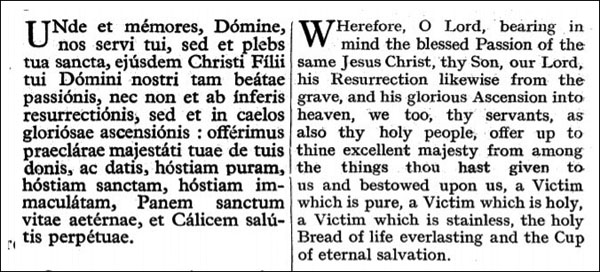
It is of importance to note that the offering of this oblation was predicted by the Prophet Malachias in these words: "For the rising of the sun even to the going down My name is great among the Gentiles, and in every place there is sacrifice, and there is offered to My name a clean oblation" (Mal 1:11)
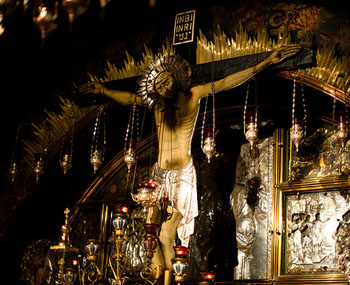
At Golgotha in Jerusalem, at the site where Christ sacrificed himself for man
Nor can the supposition be entertained that the prophecy refers to a sacrifice of praise or of good works, for these are not oblations in the proper sense of the word, nor are they always a "clean oblation."
This prophecy is consequently to be understood, as Fr. Martin von Cochem points out in his work on the Mass: "as expressly referring to the Holy Mass as the one, only and true sacrifice of the New Testament; an oblation in itself perfectly pure and holy, which is offered up to God the Father in all times and in all places by Christ himself through the instrumentality of His priests. ... This oblation will continue to be offered until the end of the world." (1)
Supra quae propitio
The priest, stretching out his hands continues the great prayer, saying:

This signifies that, in the Holy Mass, the priest is united to:
- The sacrifice of Abel, which represented the sacrifice of the Cross with which the Mass forms but one and the same sacrifice;
- The sacrifice of Abraham where the immolation took place in an unbloody manner as at the actual Mass;
- The offering of Melchisedech, which represented the sacrifice of the Mass where bread and wine mysteriously veil the divine Victim.
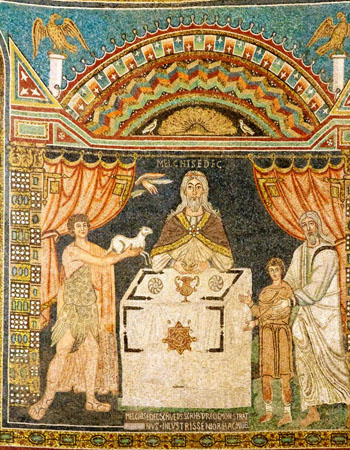
A mosaic representing the sacrifices of Abel, Abraham and Melchisedech
The priest bows low in humble supplication. Placing his joined hands on the altar, he says:
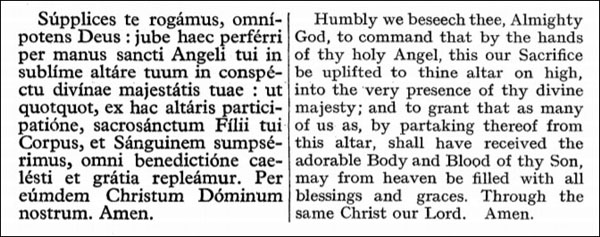
Dom Guéranger points out to us that the "holy Angel" referred to in this part is neither cherub, seraphim or archangel, for no angel can possibly execute what the priest here asks God to command to be done.
"Now observe the meaning of the word angel," he notes. "It signifies sent, and the Son of God was the One sent by the Father. He is the true Missus, the sent One, as He says of himself, Et quit misit me Pater (Jn 5:37)." Christ himself is the Angel of the great Counsel, Angelus Magni Consilii. Our Lord is not simply in the rank of those spirits – angels and archangels – placed near to us by God. No, He is the Angel by excellence." (2)
As the priest says the last three words of the prayer, he makes the Sign of the Cross. Here ends the second part of the Canon, which is that consecrated to offering.
Memento of the dead
The priest addresses himself to God, in behalf of the Church Suffering, the souls in Purgatory. "The souls in Purgatory are relieved when the sacrifice is being offered in their behalf," said St. Jerome and, indeed, this has always been the teaching of the Church.
On behalf of these suffering members, the priest addresses himself to God:
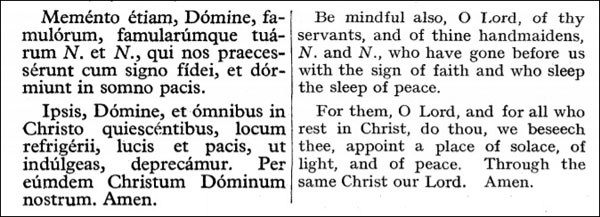
If the Mass is being offered for an individual (s), the name (s) is (are) mentioned here. The persons for whom the priest prays is marked "with the sign of faith," that is, Catholic souls marked by the sign of Baptism. Thus, Masses cannot be prayed for heretics, schismatics or infidels since they are not in communion with the Holy Church.
As noted before, the poor souls in Purgatory are enormously consoled by the Holy Sacrifice of the Mass offered for them on this earth. There are many different ways of helping the suffering souls and delivering them from Purgatory, but the Church teaches that none is so sure and so efficient as the Holy Sacrifice of the Mass. (3)
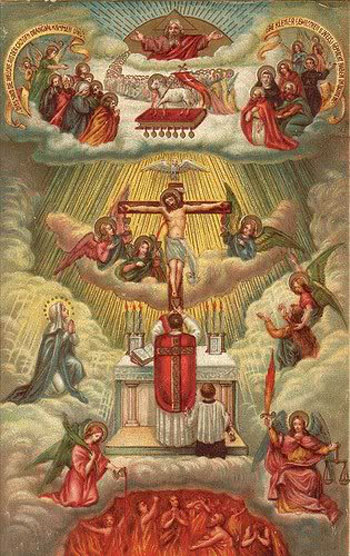
The Mass is of the greatest benefit for the suffering souls in Purgatory
The same was asserted by St. Thomas Aquinas two centuries earlier: "By no other oblation can the souls in Purgatory be more speedily released than by the Sacrifice of the Mass." (5)
One important item rarely mentioned is the value of the Mass said for the living. Fr. Cochem taught: "One thing cannot be doubted, namely, that a Mass said or heard in one's lifetime has much more satisfactory value than one said after death. According to St. Anselm, a single Mass in one's lifetime is equivalent to many after one's death."
For, he goes on to explain, every Mass which a man says or hears obtains for him an increase of glory in Heaven. This is not the case when Mass, or even hundreds of Masses, are offered for him after his death. Further, all the Masses you hear or that are said for you will await you at your death: They will go with you to the judgment seat, they will plead mercy for you, and shorten the time of Purgatory. (6)
Nobis quoque peccatoribus
The priest then strikes his breast and speaks first in the name of the Church Militant and, then, the Church Triumphant:
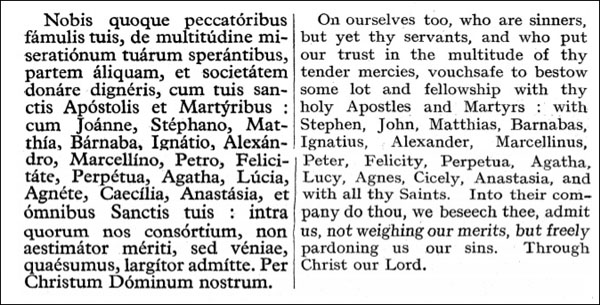
As the priest asks that we sinners might have our share of happiness, he speaks aloud, the only occasion during the Canon that he does so. He strikes his breast, and the faithful should do in like manner, says Dom Guéranger. (7)
With whom do we desire to have a share of happiness? With the Apostles and Martyrs and all the Saints that comprise the Church Triumphant.
Per quem haec omnia & the Minor Elevation
While saying this prayer, the priest makes the Sign of the Cross over the Chalice and Host at the words santificas, vivificas, benedicis, applied to the Body of Jesus Christ, which has been given to us as a life-quickening food.
As the Canon nears its close, the priest makes what is called the Minor Elevation. Here a very solemn rite is performed: It is the Church's last confession of the identity that exists between the Sacrifice of the Cross and that of the Mass.
The priest uncovers the chalice and, after making a genuflection before the Blood of Christ, he takes in his right hand the Sacred Host and in his left hand the Chalice. Then he makes the Sign of the Cross with the Host over the Chalice three times, going from one lip of the Chalice to the others, saying: Per quem haec omnia ...
He slightly elevates both saying, Omnis honor et gloria. He then puts down the Host again, recovers the Chalice and says, per omnia saecula saeculorum.
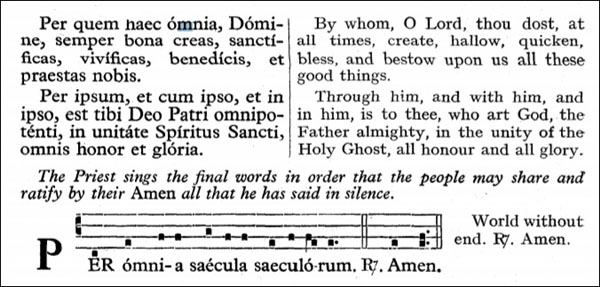
The lifting up of the victim as an offering to God," says Bossuet, "was formerly one of the ceremonies of a sacrifice. The Body and Blood of Our Lord are now lifted up in the same spirit, these being really and truly our Victim." (8)
This solemn ritual terminates the great prayer of the Canon.
Continued
- Martin von Cochem, Explanation of the Holy Sacrifice of the Mass, NY: Benzinger Bros., 1896, pp. 17-18.
- Dom Prosper Guéranger, Explanation of the Holy Mass, 1st ed. 1885, rep. Loreto Publications, 2007, pp. 152-153
- Ibid., pp 271-272
- Ibid.
- Ibid.
- Ibid., p 273.
- Guéranger, Explanation of the Holy Mass, pp. 159-160.
- St. Andrew Daily Missal, by Dom Gaspar Lefebvre, republished by St Bonaventure Publications, 1999, p. 978

Posted July 25, 2018














